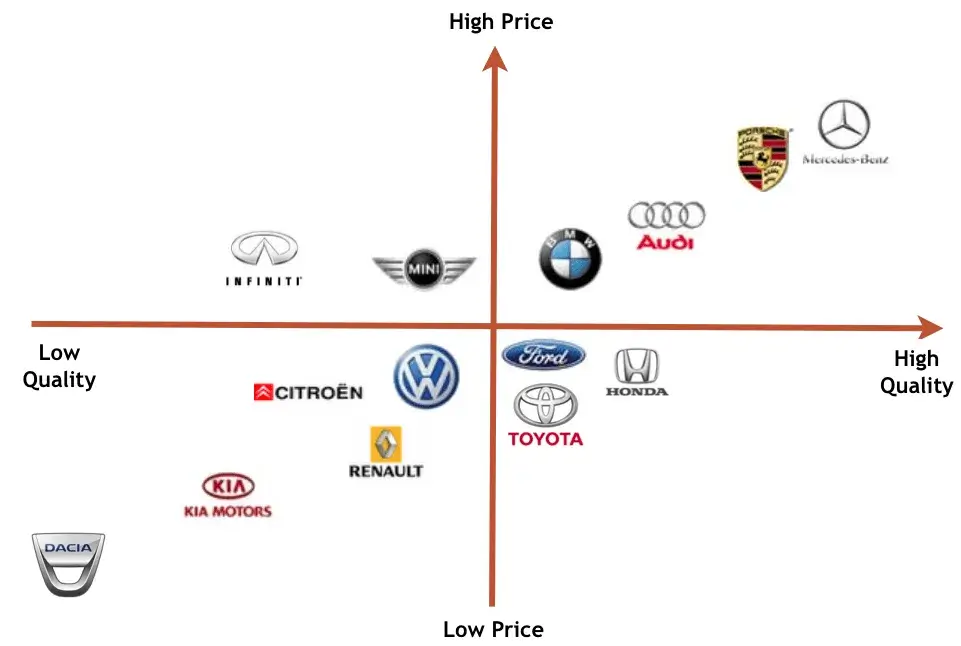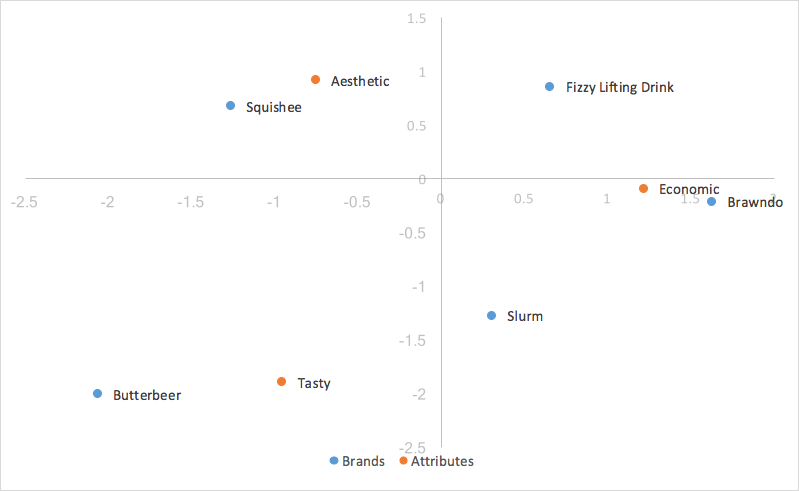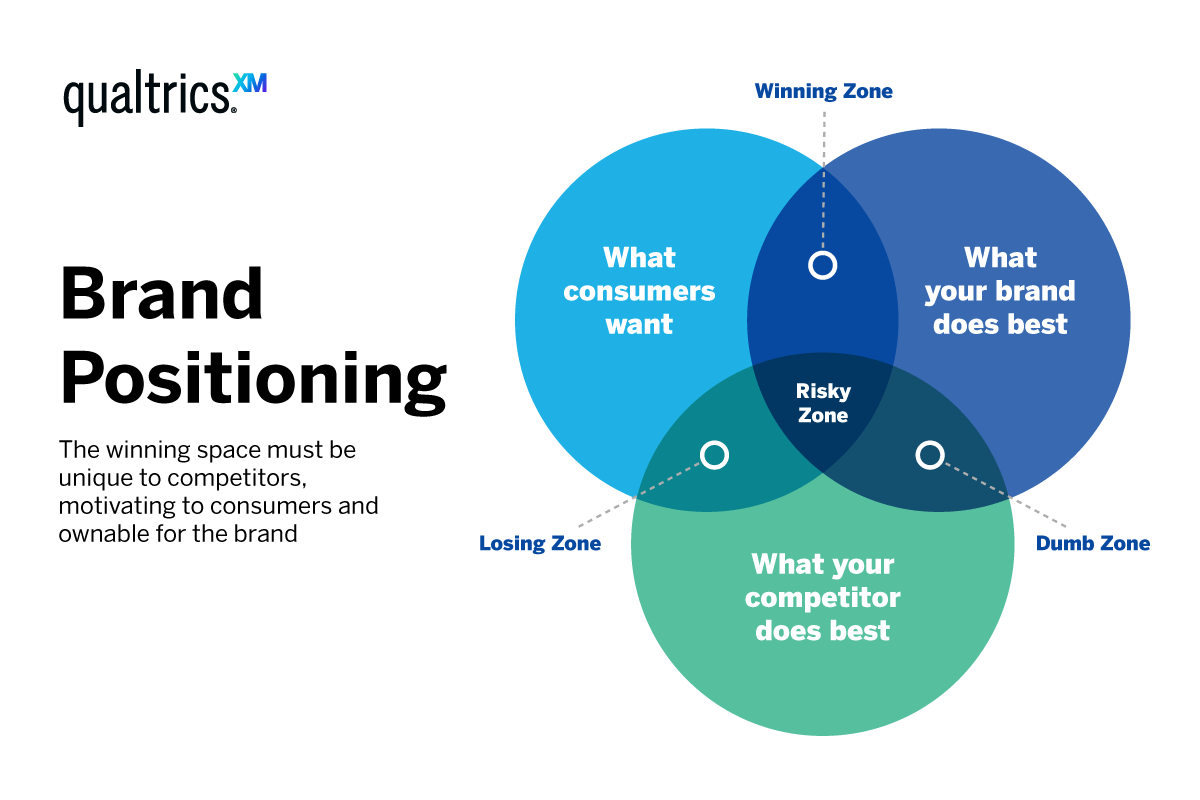The way your brand is positioned in the market ultimately determines how consumers view you and your ability to meet their needs. It determines who your competitors are in your category and, if positioned correctly, it can even determine how much people and businesses will pay for your products or services. In other words, the stakes are high. Let’s begin by outlining what brand positioning is before we dig a bit deeper into brand positioning strategy, methodology, and templates.
Free eBook: The ultimate guide to building a world-class brand tracker
What is brand positioning?
Even though 50 years have passed since it was introduced, many marketers still view the concept of positioning as the basis for brand strategy. First coined by Jack Trout in 1969, positioning was what “advertising does to the product in the prospect’s mind.”
The meaning gradually expanded beyond advertising and ultimately revolutionized branding after Trout, along with Al Reis, published their classic book “Positioning: The Battle of Your Mind” in 1981.
Brand positioning is about owning a unique position in the mind of the target consumer
Put simply, brand positioning is about owning a unique position in the mind of the target consumer, and it’s an articulation of what you want your brand to be to consumers.
It’s established relative to your competition in a way that signals differentiation and it’s about making sure that when your target consumers think of your brand, they know the unique benefits you offer. Therefore you are showing the value of your brand to your target audience.
It is a strategic document that is primarily internally focused, helping shape and guide innovation, marketing, commercialization, and sales strategies. This articulation typically addresses the following key considerations: who the target customer is for the product/service, what need(s) are satisfied with this product/service, and the reason(s) to believe that this product will satisfy their need(s).
To some extent, positioning, at least as described by Trout and Reis, can be seen as an art. But there’s a lot more to positioning than merely reflecting a position in the minds of consumers.
Fundamentally, brand positioning stands at the heart of marketing strategy. It provides the direction for strategic and tactical activities that will help an organization’s products and services stand out amid the many alternatives consumers could choose.
As such, positioning should always follow other key aspects of brand strategy—namely, market diagnosis, segmentation, and targeting. Only then should marketers seek to position the brand most effectively.
Your brand positioning might have the goal of being seen by the consumer as:
- Premium
- Good value
- The market leader
- The challenger (and with tag – different, newer)
- A safe pair of hands
- Favorable
Example: Positioning in the battery market
Brand positioning is vital in the battery market, purely for the fact that most brands sell the exact same product; the chemicals that go into making batteries are identical. So if you’re selling the same product, how do you get the consumer to pay more?
In Duracell’s case, you do it through communicating trust. Their marketing showed that everyone, whatever their purpose — however trivial or serious — trusted Duracell to get the job done. It evoked an emotional response. Then, ensuring that actions were matching their words, trust was the number one barometer to assess how effective this positioning was.
Once you’ve articulated your brand positioning, you need to communicate it. This is how you’re going to bring it to life. You might promote the attributes of your brand, or outline facts that make you the best option. The essence of your positioning needs to be tight at the beginning for this to work.
Align your brand to the experience
So you’ve positioned your brand in the market, you know who your competitors are, and you know your target audience. You’ve talked the talk. Now you’ve got to walk the walk. This is why brand experience is so important. The experience you provide to both customers and potential customers must match up to their expectations – and this is, in part, set by how you position your brand, how you communicate your offering, and ultimately how your business can help.
Why is brand positioning important?
Brand positioning is essential because it helps you to differentiate your product or service from another. As a brand, you have to show your target audience what you do and make them believe in it. Brand positioning helps you achieve that goal. It’s about communicating to the world what you bring to the table, and importantly — what is different about you.
Brand positioning increases the strength of the business. A consumer or prospect will weigh the perceived advantages and your ability to meet their needs before making a purchase, and how you position your brand to meet these needs will determine how likely they are to go with you.
Evoking emotion
In some cases, the product offering between brands is very similar. As such, the differentiation doesn’t come from the technical aspects of the product or service, but rather the emotion that’s elicited when buying the product. For example, higher levels of trust in the product might generate peace of mind, or a lower price might make you feel more satisfied that you’ve managed to save money.

Steps to create your own brand positioning
Brand positioning begins internally, and your own brand positioning strategy should be specific to your business. Begin by asking yourself:
Who – you are targeting
What – is the need you are serving
Why – your audience should believe you
The “who” is where market segmentation happens, determining which audience is most likely to buy from you, and who is most in need of your products and services. Once you have determined this, they become your target audience – this is where your priorities and actions will primarily focus. (There may be times when you look to expand this target audience and appeal to a wider demographic of people). The “what” is what problem is solved by your product, what need is met by this brand? The “why” is a reason to believe that your brand is better than other brands at solving the problem, and meeting the need.
The key to successful brand positioning is remembering that this is the art of strategy. This is not about tactics. If you make the mistake of thinking of the tactics (how you’re going to communicate your brand), you’ll neglect the ‘why’ – why your audience will believe you can meet your audience needs, which is much more fundamental to your success.
Remember to keep this reason for being very clearly articulated. That way, it’s easier to stay true to your positioning and see when you’re deviating.
Next steps:
- Communicate it internally – Send it to your key stakeholders in product, marketing and communications, and HR teams. It needs to be reflected in every business decision you make, within every department.
- Communicate it externally – You have created a product or service for a particular need—now, how are you going to market it?
To summarize: It’s crucial that you understand the need you’re meeting for your customers. To do this, you must understand the target audience you will be serving. Then communicate to that audience your positioning—what you can offer and why they should believe you.
To begin, get your positioning locked internally. Then, execute this externally. Depending on your circumstances you might focus on an advanced product offering or feature, but if these are very similar, then evoking emotion – trust, excitement, happiness, etc – are effective ways of distinguishing yourself from the rest.
Examples of effective brand positioning
Brand positioning is, in part, set by your market conditions. If you’re a challenger brand, you can’t claim to be the market leader when another brand holds the majority of the market share. However, you can make your brand distinctive and differentiate yourself from the rest with alternative messaging.
Some of the most famous brand positioning examples have also resulted in the most famous advertising campaigns.
AVIS (vs Hertz)
“We try harder”
Avis held the tagline ‘We Try Harder’ for 50 years. Why? Because they embraced being the challenger brand. Being the challenger brand made them try harder. They want to be the best, so as the consumer you’re going to get a better experience for what you pay, in the hope you’ll come back and use Avis instead of Hertz.
This positioning helped to elevate Avis, despite being the second biggest car rental company. In fact, that was their very point. Their message was: Don’t write off the underdog, you’ll get a better quality of service.
McDonalds vs Burger King
The relationship (or competition) between McDonalds and Burger King is a really interesting one, and certainly a fantastic example of two styles of brand positioning.
On the one hand, you have Burger King. The challenger brand, cheeky in their tone of voice and even more so in their (not so) subtle digs and stunts aimed at McDonalds and their products. Their communications have won fans, awards – and customers, all around the world.
On the other hand, you have McDonalds. Who are renowned as the leader in their category, and refuse to respond to Burger King – because as soon as they acknowledge them, they’re not distancing themselves from their competitors and their status as category king can be disputed.
Apple
“I’m a Mac”
Apple personified their product offering in an advertising campaign called “I’m a Mac”. Positioning the Mac as newer, cooler and more casual than an out of touch PC, Apple were able to position their product – and brand, exactly where they wanted to – as more modern, hip and easy-going, compared to Microsoft
Free eBook: The ultimate guide to building a world-class brand tracker
Brand positioning strategies
You can build out your brand positioning strategy from one of several starting points that can help you find your brand’s place in the market and articulate your brand promise. Your chosen brand positioning strategy will help you influence your customers by letting them know the most important thing about your offering.
Here are five brand positioning strategies to consider:
Price
In this instance, your brand positioning will focus on how you offer market-leading value. People will begin to know you as the more affordable alternative, or one whose value warrants the higher pricetag.
Characteristics
Your brand positioning strategy can help you synonymize your brand with specific personality traits or characteristics like safety, fun, speed, or reliability.
Use
The specifics of your product’s application can help you find a point of differentiation, a unique audience, and memorable brand positioning. For instance, if you sell accounting software aimed at freelancers, your product application is inherently different from those aimed at large enterprise firms, and vice versa.
Quality
You may wish to position your brand at the very top of the market, where the price of your product becomes less relevant than its perceived luxury.
Competition
Lastly, if your brand is an underdog compared to your nearest rival, you may wish to lean into that. Think Pepsi with the Pepsi Challenge. Just remember: it’s fine to punch up, but don’t punch down.
The brand positioning statement: definition
The “brand positioning statement” is a short strategic document that synthesizes the value that the brand brings to a particular market segment. Your brand positioning statement solidifies everything you want people to think of when they think of your brand.
Unlike slogans, positioning statements are developed for internal purposes and aim to reflect the competitive advantage defined.
While the overall statement should be aspirational, it can’t be so far removed from the reality of the current situation as to lose credibility in the minds of consumers.
Brand positioning statement examples
Brand positioning statements are internal documents, and when this positioning is ready to go public it is used to brief external campaigns. The external slogan is a creative interpretation of that brand positioning. The brand positioning statement should be short, simple and leave no room for ambiguity.
An example of note is Nike’s brand positioning. This is because as they became more successful, the business had to adapt and their positioning statement reflects this.
First off, Nike was targeting runners. So, to reflect this the positioning strategy was ‘The lightest shoe in the market that would last in longer-distance running at a price lower than the German brands in the market’.
As Nike became more popular, this evolved to – “For serious athletes, Nike gives confidence that provides the perfect shoe for every sport”.
However, an example that highlights the difference between internal and external communications, the Nike slogan renowned throughout the world is “Just do it. An active phrase that empowers everyone in sport, and wider society too. In fact, the slogan is used to position Nike on some of the society’s most important issues, most notably the racism row in America with Nike supporting Colin Kaepernick in a historic campaign in 2018.
Believe in something, even if it means sacrificing everything. #JustDoIt pic.twitter.com/SRWkMIDdaO
— Colin Kaepernick (@Kaepernick7) September 3, 2018
This was the beginning of Nike’s very vocal positioning on inequality in society, that led to a shift in messaging that resonated the same tone. In May 2020, Nike released an advertising campaign across social media – including their sponsored athletes, with the tagline “For once, don’t do it”, as they advocated we all be part of a needed change for an equal society.
Let’s all be part of the change.#UntilWeAllWin pic.twitter.com/guhAG48Wbp
— Nike (@Nike) May 29, 2020
Building a strong brand positioning statement: Methodology
Ready to build your brand positioning statement? The methodology revolves around being able to succinctly and honestly pinpoint your place in the market, as well as what customers in your target market are looking for.
If that seems like a tall order, just remember that the most important thing is to focus on the three Cs…
The three Cs:
Consumers: It’s all about who you’ve chosen to serve, and being relevant to them, i.e. focusing on value claims that will resonate and, in turn, make your brand desirable to those consumers. From features, attributes, and special ingredients (the ‘what’), to the benefits your consumers receive (the ‘what’s in it for me’), to the deep-seated needs & values your consumers aspire to (the ‘why’).
Competitors: Focusing attention on your competition within a chosen frame of reference will help zero in on specific claims that are believed to distinguish the brand from its competitors. Managers may use perceptual mapping (see Fig. 1) as a way of identifying how people perceive the various brands in the market, and what favorable position may exist.

Fig 1: Example of a perceptual map (correspondence mapping) generated in Qualtrics
Company: This point is about ensuring the positioning statement is realistic and can be delivered reliably at every interaction with customers. Some brand positions will be easier to infuse into all aspects of operations than others, which in turn will result in more value being created.
By focusing on who to serve, where to play, where to win, and why consumers should believe you, the main guiding principle for crafting a positioning statement can simply be expressed as:
“For [target market], Brand X is the only brand amongst [competitive set/category] that [unique claim/benefit] because [reason to believe/support points].”
And remember…
Keep it short, simple, and tight
Doing so ensures it’s easily conveyed across the organization. In terms of communicating the essence of your positioning, various strategies can be used.
A popular approach is to promote features and attributes you believe competitors can’t match (e.g. Westin’s heavenly beds) which suggests other options are sub-optimal.
Another popular approach is to directly position the brand against your main rival. This is the case of Avis’ “we try harder” campaign that targeted Hertz and cleverly turned its weakness into a strength.

Brand positioning statement templates
Once you’ve thoroughly explored your target market, your brand promise, and your value proposition, it’s time to write your own brand positioning statement. This will usually only be a few lines long, but it should distill everything your brand represents into a solid piece of messaging – one you can use to inform everything from your marketing strategies to your brand voice.
But don’t worry, it doesn’t need to be a complex task. You can use this simple brand positioning statement template to build a paragraph from five separate statements.
Brand positioning framework and template:
For: Identify the ideal market segment
Example: The business person who is starting a new company
Product is: Provide a concise description
Example: Software that produces a business plan
Ideal for: Describe best use or application for the product
Example: Quickly and easily creating a professional business plan
Better than: Identify primary competitor or competing approach
Example: [Insert competitor]
Because: Cite differentiation and other evidence to back up your claim of superiority
Example: It is a stand-alone product and requires no other programs to buy or learn
Cited from ANA
You can think of the resulting brand positioning statement as an elevator pitch; it’s short enough to be shared with anyone and have them understand what your company is, what it does, and who it’s for.
How to communicate your brand positioning to stakeholders
Your brand positioning statement is a living document, and your brand positioning strategy is how you’ll bring that living document to life. Therefore it’s really important that the whole company has bought into the vision, what you’re trying to achieve, and why your offering will help you achieve that vision.
Brand positioning is the strategy, but communicating this brand positioning requires tactics that are well thought out. This begins internally, with an internal communications program that brings everyone together, with everyone working towards the same goal by using your positioning statement as your guiding principle. This includes every department including leadership, operations, sales, marketing, and customer service. Bringing all facets of your company together enables everyone to deliver consistent experiences that benefit the customer and the brand simultaneously.
Once things are established internally, this brand positioning statement should be communicated externally. There are different tactics you could employ here, dependent on the goals you’re trying to achieve. (Think Mcdonald’s vs Burger King – both have very different tones and styles).
Ultimately your brand positioning should be reflected when you execute your marketing strategy. But whatever tactics you choose— events, advertising, press briefings, etc,—should clearly articulate the need you serve, why your target audience should believe you, and ultimately why they should choose you over your competitors.
Examples of communicating brand positioning include:
Amazon – “From A to Z”Nike – “Just do it”
Avis – “We’re number two. So we try harder”
Lloyds (a major UK bank) – “By your side”
How to improve your brand position over time
Brand repositioning isn’t a quick fix. Improving or repositioning your brand may be a consequence of poor business performance or changing consumer needs. However, it should only be undertaken after extensive research. There are three factors that should be considered in this process:
Data – This should inform your decision and give you confidence in the actions you take. You need to understand the market conditions you’re currently in, and how these might evolve in the future. You should also know your current and potential market segments so that any shift in positioning better suits their needs.
Communication – Any shift in brand positioning will require tough conversations with leaders and departments throughout the organization. You need to get buy-in from everyone to make this a success. Not everyone will agree, and this is where the final point is important.
Vision – Having a clear vision that’s backed by data will help with those tough conversations. It will also act as a point of guidance for you to measure success during this process. Keep on referring back to that vision to make sure that’s the direction you’re headed.
Keep a long-term view
As mentioned above, a positioning strategy is not a quick process. For big brands, this might be a strategy that spans years. In some cases, it may need investment, acquisitions, and marketing to shift your positioning and make people believe in this new offering. The internal shift in positioning does not always equal an automatic external shift in consumer perception.
It will take time to change people’s perception of what you offer now versus what you offered previously. Your repositioning may also target new market segments, so bear in mind that your brand may be entirely new to some of your audience.
Back up what you say with what you do
One mistake many brands make is that they create advertising that is far away from their brand. What they say and what they do are two different things. In fact, a brand’s purpose is sometimes used to justify this marked difference, by blurring the lines between positioning and purpose.

These brands are so eager to have an opinion on societal or environmental issues that the brand’s messaging is at risk of becoming less about competitors and instead focusing on a very large target audience so they can have relevance – often forgetting about who they are, and the need they set out to meet at the very beginning.
When this happens, a conflict is created between what they say and what they actually do, and the brand is then at risk of erring away from its strategy and intended vision.
How Qualtrics can help
Qualtrics BrandXM can help give your marketing actions impact. With all your data and insights in one platform, have the confidence in understanding your market segments and know that you’re on the right path. Monitor your brand, understand your market and your competitors – and make it easy to find breakthrough insights that will help turn your brand into a religion.
And, if you don’t have a team of research experts in-house, Qualtrics Research Services can help. You’ll be able to go straight to your market and hear how your target audience is feeling so you can better meet their needs, make more informed decisions and align your positioning more accurately.
Free eBook: The ultimate guide to building a world-class brand tracker